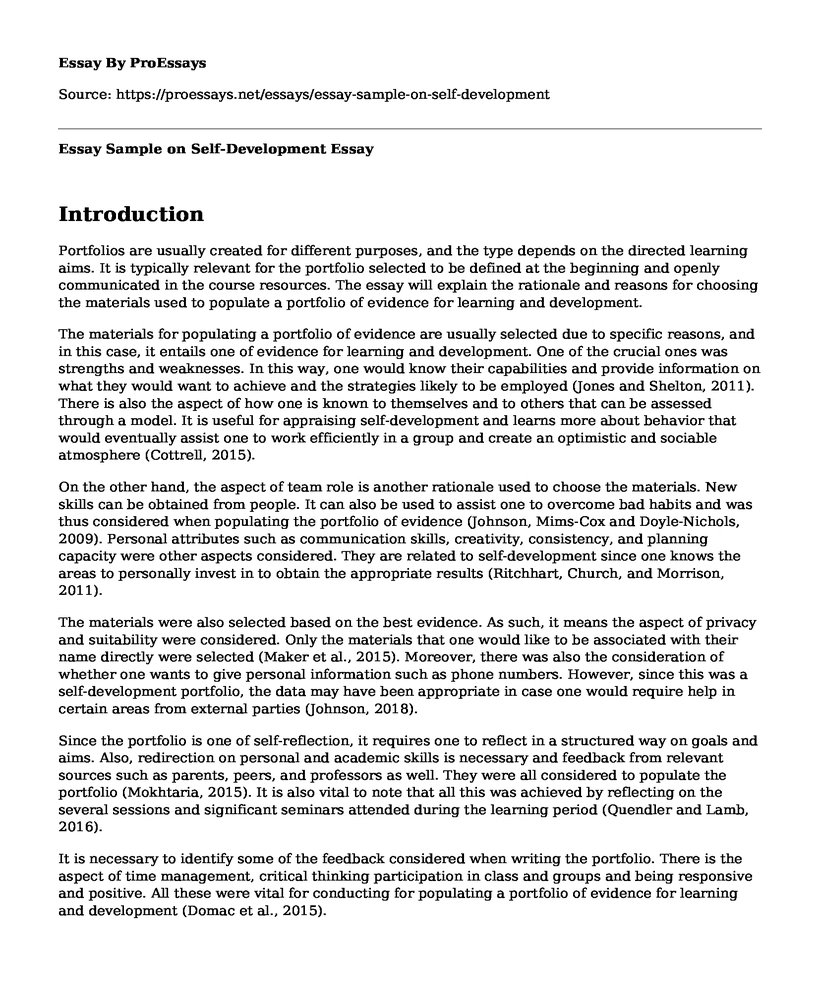Introduction
Portfolios are usually created for different purposes, and the type depends on the directed learning aims. It is typically relevant for the portfolio selected to be defined at the beginning and openly communicated in the course resources. The essay will explain the rationale and reasons for choosing the materials used to populate a portfolio of evidence for learning and development.
The materials for populating a portfolio of evidence are usually selected due to specific reasons, and in this case, it entails one of evidence for learning and development. One of the crucial ones was strengths and weaknesses. In this way, one would know their capabilities and provide information on what they would want to achieve and the strategies likely to be employed (Jones and Shelton, 2011). There is also the aspect of how one is known to themselves and to others that can be assessed through a model. It is useful for appraising self-development and learns more about behavior that would eventually assist one to work efficiently in a group and create an optimistic and sociable atmosphere (Cottrell, 2015).
On the other hand, the aspect of team role is another rationale used to choose the materials. New skills can be obtained from people. It can also be used to assist one to overcome bad habits and was thus considered when populating the portfolio of evidence (Johnson, Mims-Cox and Doyle-Nichols, 2009). Personal attributes such as communication skills, creativity, consistency, and planning capacity were other aspects considered. They are related to self-development since one knows the areas to personally invest in to obtain the appropriate results (Ritchhart, Church, and Morrison, 2011).
The materials were also selected based on the best evidence. As such, it means the aspect of privacy and suitability were considered. Only the materials that one would like to be associated with their name directly were selected (Maker et al., 2015). Moreover, there was also the consideration of whether one wants to give personal information such as phone numbers. However, since this was a self-development portfolio, the data may have been appropriate in case one would require help in certain areas from external parties (Johnson, 2018).
Since the portfolio is one of self-reflection, it requires one to reflect in a structured way on goals and aims. Also, redirection on personal and academic skills is necessary and feedback from relevant sources such as parents, peers, and professors as well. They were all considered to populate the portfolio (Mokhtaria, 2015). It is also vital to note that all this was achieved by reflecting on the several sessions and significant seminars attended during the learning period (Quendler and Lamb, 2016).
It is necessary to identify some of the feedback considered when writing the portfolio. There is the aspect of time management, critical thinking participation in class and groups and being responsive and positive. All these were vital for conducting for populating a portfolio of evidence for learning and development (Domac et al., 2015).
Conclusion
The essay has explored the rationale and reason for choosing materials used to select materials used to populate a portfolio of evidence for learning and development. It has been observed that it is crucial to consider strengths and weaknesses to know one's capabilities and offer information on what they would want to achieve and strategies to utilize. Also, a reflection on goals and aims is fundamental and feedback from parties such as professors, peers, and parents is required to identify the aspects of time management, critical thinking, and being positive and responsive.
References
Burksaitiene, N., Tereseviciene, M. and Kaminskiene, L., 2011. Portfolio use for documentation of personal and professional growth gained outside academia. Baltic Journal of Management, 6(2), pp.245-262.
Cottrell, S., 2015. Skills for Success: Personal development and employability. Macmillan International Higher Education.
Domac, S., Anderson, L., O'Reilly, M. and Smith, R., 2015. Assessing interprofessional competence using a prospective reflective portfolio. Journal of interprofessional care, 29(3), pp.179-187.
Johnson, R.S., Mims-Cox, J.S. and Doyle-Nichols, A., 2009. Developing portfolios in education: A guide to reflection, inquiry, and assessment. Sage.
Johnson, P., 2018. Fundamentals of collection development and management. American Library Association.
Jones, M., and Shelton, M., 2011. Developing Your Portfolio-Enhancing Your Learning and Showing Your Stuff: A Guide for the Early Childhood Student or Professional. Routledge.
Maker, C., Alhusaini, A.A., Pease, R., Zimmerman, R. and Alamiri, F.Y., 2015. Developing Creativity, Talents, and Interests across the Lifespan: Centers for Creativity and Innovation. Turkish Journal of Giftedness & Education, 5(2).
Mokhtaria, L., 2015. The use of portfolio as an assessment tool. International Journal of Scientific & Technology Research, 4(7), pp.170-172.
Ritchhart, R., Church, M., & Morrison, K. (2011). Making thinking visible: how to promote engagement, understanding, and independence for all learners.
Quendler, E. and Lamb, M., 2016. Learning as a lifelong process-meeting the challenges of the changing employability landscape: competencies, skills and knowledge for sustainable development. International Journal of Continuing Engineering Education and Life-Long Learning, 26(3), pp.273-293.
Cite this page
Essay Sample on Self-Development. (2022, Mar 13). Retrieved from https://proessays.net/essays/essay-sample-on-self-development
If you are the original author of this essay and no longer wish to have it published on the ProEssays website, please click below to request its removal:
- Case Stude Example of Major Depressive Disorder
- Collaboration Leadership in Development of a Mental Health Care Agency
- Essay Example on Prisons Rehabilitation Policy Manual
- Shakespeare and Ovid: A Literary Tale of Love and Metamorphosis - Essay Sample
- Essay on My Objectivist Beliefs: How Self-Interest, Reason, Capitalism, and Reality Unify
- Essay on Understanding Life's Purpose: The Journey for Meaning and Knowledge
- Three Friends and a Fight: Friendship Put to the Test - Essay Sample







